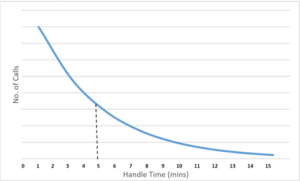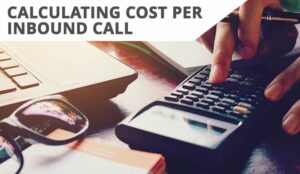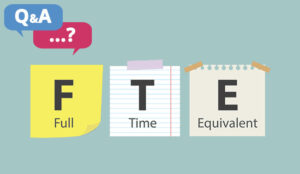Cost per call (CPC) is a way of understanding how the contact centre budget is divided between the incoming contacts. When looking at CPC it’s important to understand that it doesn’t describe the total amount of expenditure but how expenditure relates to the workload.
This makes a world of difference, and it’s also the reason that this figure is so often misunderstood. It helps to remember that cost is not the only variable in CPC – volume is also very important – as shown in this simple example:
| Total Loaded Cost | Call Volume | CPC | |
|---|---|---|---|
| Month 1 | £304,000 | £95,000 | £3.20 |
| Month 2 | £320,000 | £114,000 | £2.80 |
| Month 3 | £324,000 | £100,000 | £3.20 |
In this example, total cost rises between Month 1 and Month 2, but because call volume also rises, the CPC goes down instead of up. Then between Month 2 and Month 3 call volume declines, but now the total cost is steady, so CPC increases again.
How to Calculate Cost per Call
The fundamental calculation for CPC isn’t complex. You take the fully loaded cost of your contact centre for a given period and divide that between the number of contacts in the same period.
Cost per Call Formula
Cost per Call = Total Operational Expenditure ÷ (Calls Offered − Calls Abandoned)

You’ll need to find the right people within your business to provide costs for the following:
- Wages, national insurance (in the UK) benefits and bonuses
- Management, HR and recruiting
- Building costs, maintenance, power and Rent
- Software licensing and Hardware rental
- Overheads
Include all operational costs related to running the contact centre. Depending on your business structure, multiple stakeholders may need to contribute data, and some costs may overlap across departments.

We spoke to Charles Adams, who explained: “In an old-school call centre that just takes hundreds of the same types of calls, throw all costs into the equation – especially when you’re outsourcing and you really need to see the true cost.
However, these days a lot of call centres are actually ‘contact centres’, handling an array of channels, and sometimes balancing resource by multitasking.
In these set-ups it is increasingly hard to apply the same equation or logic. In those cases we put all ‘non-directly associated’ costs in a separate bucket.”
To calculate costs accurately, it’s essential to know which calls are being measured. Instead of using resolved calls from a CRM, it makes more sense to base calculations on calls offered by the ACD, minus abandoned calls. This avoids counting transferred calls twice, which could artificially lower the CPC.
While there’s no official CPC benchmark, our webinar study found an average of £3.64.
Why Is Cost-per-Call Useful?
Given that CPC doesn’t really reflect expenditure, the obvious question might be ‘what is it good for?’ There are several ways a contact centre might choose to use their CPC data.
Understand the Cost of Customer Experience
CPC helps connect the contact centre’s costs to its impact on customer experience, facilitating clearer discussions with other departments. This understanding can secure additional resources by demonstrating the contact centre’s role in customer satisfaction and retention.

Call centre operations consultant Nick Bhugeloo advises, “Look at the investment you put in to generate the calls – say £50,000 in marketing – and then look at the number of calls that result.
At the end, how many calls have converted into a sale? That then gives you your cost. It’s more about the effectiveness of your marketing. “
If a marketing campaign increases inbound calls, the cost per call may drop, but this doesn’t always reflect operations accurately. The priority should be delivering strong customer experience – answering calls promptly and providing needed support.
Evaluating Costs From Other Departments
CPC can highlight the costs generated by other departments, such as complaints or queries, which helps demonstrate that the contact centre is not solely responsible for its expenses. By presenting this data, contact centres can raise awareness of costly areas in the wider business that impact customer contacts.
Calculate the Cost of Separate Call Types
Breaking down CPC by different call types enables contact centres to identify which calls are consuming the most resources.
This granular analysis can reveal opportunities for improvement or investment, whether that’s focusing on high-value activities like retention or considering outsourcing options for specific call types.
How Can Cost per Call Be More Granular?
Making Cost per Call data more actionable often requires breaking it down by the types of contacts a contact centre handles. Here are two approaches to achieve this:
Cost per Contact
A straightforward way to categorise CPC is by contact channel (e.g., phone, email, chat). In environments where agents handle only one channel each, this is relatively simple:
- Step 1: Calculate the total costs for each channel (e.g., exclude telephony infrastructure costs when calculating email costs).
- Step 2: Subtract costs that are not related to that activity
However, for centres where agents handle multiple channels, separating costs can be challenging. In these cases, you can allocate costs based on contact volume.
Nick Bhugeloo says, “Say you have 3,000 calls in a month, and 5,000 emails, and you’re doing 600 tweets – you put all of this together, and then you average the time and divide the volume by time to get the cost per contact.”
Keep in mind that accuracy can be limited since call durations are fixed (e.g., 7 minutes), while emails or chats may vary (e.g., 3 to 20 minutes).
Cost per Working Minute
An alternative is to calculate the Cost per Working Minute. You can do this by dividing the total operational cost by the total number of minutes agents spend handling contacts.
What’s the benefit? Well, for contact centres with some variability in call length, the average CPC might not be very representative. Cost per Working Minute, however, does not depend on AHT, so can be applied evenly to every call.
Some Key Considerations for Cost per Call
Understanding the nuances of Cost per Call is essential for effective contact centre management. Here are some key factors to keep in mind:
New Technology Might Increase CPC
Adopting cloud-based services can reduce overall costs by shifting expenses from capital expenditure (CapEx) to operational expenditure (OpEx). While this change can save money for the business, it may temporarily increase CPC due to higher operational budgets.
Longer Calls May Skew Costs
Call duration can impact CPC disproportionately.
For example:
- Shorter Calls: Handling five two-minute calls may be more productive than one ten-minute call.
- Longer Calls: These often address complex or high-value issues (e.g,. service renewals), which can justify their higher cost but contribute to longer queue times.
The argument for this is that productivity is measured by how many customer queries are resolved in total, so solving five calls is five times more productive than solving one. Longer calls also contribute to longer queue times.

This covers a lot of variability between businesses, which also place very different values on calls of varying lengths.
The average two-minute call is likely to be low value, like a password renewal. The average long call is likely to be high value, like a service renewal.
Inbound calls follow a Poisson distribution (see above), meaning that while calls above and below AHT represent equal volume, there are more separate short calls.
CPC Is Not a Good Moving Target
CPC can fluctuate due to multiple variables, making it unsuitable for daily or moment-to-moment tracking. Consider a contact centre that changes supplier for all hardware and saves 20%. How long will it be before the business is actually any cheaper to run?
Instead, businesses should measure CPC monthly to quarterly to provide a clearer trend over time. Nick Bhugeloo adds that:,
“Finding out a month-on-month cost per call isn’t relevant, but finding out what drives the fluctuations is. Let’s say that your cost-per-call for one month was £25, and the next month it’s £35. What does that mean to you in isolation? It might be that in month two you’ve doubled the profits.“
Reducing Costs May Not Always Lower CPC
Efforts to reduce overall contact centre costs – such as implementing self-service, automation, or improving First Contact Resolution (FCR) – can lower the number of calls. However:
- Fewer Calls = Higher CPC: If costs remain steady but call volume drops, CPC will increase temporarily.
Instead of focusing solely on CPC, consider the effectiveness of cost-saving strategies and their long-term impact on customer experience and operational efficiency.
As Nick Bhugeloo points out, “This is not a measurement to get too hung up on – if your general strategy is to bring down costs… Basically, reduce your call volume. If you don’t get that many calls, you don’t need the same level of resource to handle them.”
If you are looking for information on calculating other key call centre metrics, read these articles next:
- How to Calculate Your Cost Per Inbound Call
- What is Call Centre Shrinkage and How to Calculate It?
- How to Calculate Contact Centre Service Level
Author: Megan Jones
Reviewed by: Hannah Swankie
Published On: 27th Sep 2017 - Last modified: 10th Dec 2024
Read more about - Customer Service Strategy, Charles Adams, How to Calculate, Metrics




































